|
ROCKY MOUNTAIN National Park |
 |
Animal Life (continued)
RODENTS AND RABBITS
Although every park visitor sees numerous examples of its work, relatively few see the BEAVER. Working at night, as a rule, it usually remains out of sight when humans are abroad. These interesting animals are rodents—relatives of the chipmunk and marmot. They become quite large; some have been live-trapped locally and their weight found to be over 90 pounds. Beaver pelts were part of the lure which led to the early exploration of the West. Almost exterminated about 40 years ago, they are now relatively abundant in Rocky Mountain National Park.
The beaver is well adapted to its watery environment. The hind legs are webbed for efficient swimming, and the tail is broad and horizontally flattened, making an excellent rudder. Its swimming speed at the surface of the water is only about 2 miles per hour. Beaver can remain submerged for over 5 minutes, which is helpful in escaping enemies.
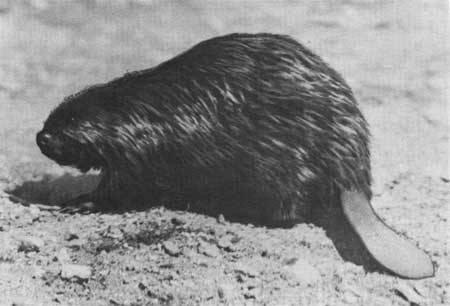 THE BEAVER IS SOMETIMES SEEN BY ALERT OBSERVERS IN LATE AFTERNOON OR EARLY MORNING. |
Beaver dams are abundant in the park. Many typical examples can be seen in Horseshoe Park, along Trail Ridge Road, in Hidden Valley, at Milner Pass, and on the Colorado River. Nearly all of the park trails pass beaver workings. The dams are built of various materials in this region, but most commonly of parts of aspens, mud, and other debris. They are started from the upstream side—usually on shallow creeks—and as the water level rises so does the dam. The beaver uses its front paws almost as hands. The load of mud or sticks sometimes is carried by being pressed against the chest as the animal walks on its hind feet to the top of the structure it is building. The dam is made to create a stabilized water level. This is essential for protection of the beaver's island den—a lodge made of sticks and mud. The beaver house starts as a solid heap of debris, but the animal chews and digs out a couple of underwater tunnels, as well as one or more dome-shaped rooms with the floor a few inches above the water level. In this dry retreat the beaver rests, sleeps, and rears its family. Few natural enemies can pursue it through the underwater entrances. Its food is chiefly aspen bark and twigs obtained in water, principally from the "foodpile."
Because of its energy, the beaver has become a symbol of eagerness. It is also often credited with intelligence, which it probably does not possess. Its apparently ceaseless work is more likely due to inherited instincts than to reasoning. Nevertheless, it is one of the most interesting animals in the park.
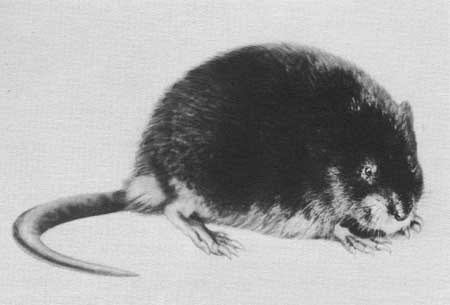 RATLIKE TAIL DISTINGUISHES THE MUSKRAT, WHICH MAT LIVE IN THE SAME VICINITY AS BEAVERS. —Fish and Wildlife Service photo. |
The MUSKRAT is frequently active in daylight hours. It lives in the same environment as the beaver, but in the park has a much more limited distribution and is confined to lower elevations. It builds lodges, too, although much smaller than those of the beaver, which are largely composed of mud and herbaceous matter. The lodge serves as a secondary food source in the winter, and many muskrat houses are practically eaten away by spring. Unlike the beaver, which is a vegetarian, the muskrat also eats other food, including fish, insects, and any birds it can catch. The muskrat has not attained the ability to build dams, but does make rafts of sticks and twigs. Few people mistake a muskrat for a beaver when seen closely, for it is much smaller and has a slender tail, somewhat flattened vertically, quite unlike that of the beaver.
Probably everyone recognizes the PORCUPINE. It is a large, short-legged rodent, rather clumsy of behavior, and usually seen either sleeping or leisurely chewing the bark of a tree. The porcupine survives, despite its sluggish behavior, because of the protection afforded by some 30,000 quills in its pelage. Although it cannot "throw" these quills, they are very loosely attached, and when the tail is vigorously thrashed about it is inevitable that some of the quills become detached and fall away. The unlucky recipient of such a slap of the tail will be convinced that the quills were thrown, although the effective embedding of quills is done by direct contact.
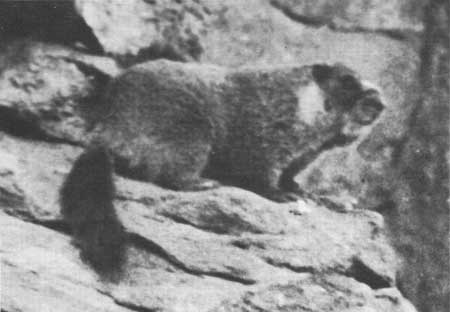 THE MARMOT IS SEEN BY ALMOST ALL PARK VISITORS. |
The MARMOT, with its reddish underpart and grizzly-gray colored back and bushy tail, is seen by nearly all park visitors. Although it is more common in lower altitudes, it also may be seen high along Trail Ridge Road, and a pair, reportedly, is living atop Longs Peak! Marmots live in dens, usually rockpiles, into which they pack twigs and grass to make a comfortable nest. They store up a heavy layer of fat in the summer and hibernate during the cold winter. Their natural food consists of grass, berries, and roots. Their short, sharp whistle can be heard a mile distant. During the summer, hikers occasionally see rather humanlike family scenes, as the marmot family sun themselves on the "front porch" of their rockpile home.
The TUFT-EARED, or ABERT, SQUIRREL is an excellent example of the zonal specialization of mammals. It is almost entirely restricted to the ponderosa pine forest belt. The showy ear tufts of this squirrel set it apart from other local squirrels, although these are often absent during the summer. It feeds mostly on ponderosa pine seeds, the bark of twigs and young trees of this species, and such wild fruits and succulent vegetation as is available. The Abert squirrel builds nests in the trees and is a familiar sight to hikers in the ponderosa pine forests. It is usually gray-colored, but may be brown or even completely black.
Another small arboreal rodent, the PINE SQUIRREL, or CHICKAREE, exceeds the Abert squirrel in its chattering and scolding when a stranger enters its patch of forest. It roams both the lodgepole pine and the higher spruce-fir forests with their bitter winters, yet it does not hibernate. Even after the most severe storms it will emerge to travel through the treetop world which it occupies. Some bird enthusiasts have little sympathy for it, because of its habit of eating eggs and young birds whenever the opportunity presents itself. However, in a national park the squirrel's desire to live is considered to be as important as is the bird's. A certain "balance" of population is the result, which is, after all, one of the desirable features in an area dedicated to preserving natural conditions.
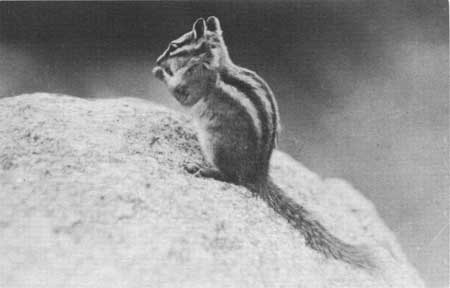 FRIENDLY CHIPMUNKS MAKE THEMSELVES KNOWN THROUGHOUT THE PARK. |
A familiar small rodent of the Trail Ridge Road parking areas is the CHIPMUNK. It is reddish-brown in color and has four white stripes running along the back. It has a definite stripe across its face, distinguishing it from the Say's ground squirrel with which it is often found.
SAY'S GROUND SQUIRREL is often confused with the smaller chipmunk, which it joins in "begging" for visitor handouts at the lower-elevation parking areas on the Trail Ridge Road. It hibernates through the winter. Its natural food is succulent plant material and seeds, but many of these gregarious little animals are more or less becoming dependent upon food offered them by humans. You can see them most conveniently at Many Parks Curve.
Another little rodent abundant in the lower meadows is the WYOMING GROUND SQUIRREL, often called "picket-pin." It lives in colonies, after the fashion of the prairie dog of the plains. This species may be extending its range to the higher altitudes. It is abundant in Moraine Park.
The COTTONTAIL is often seen in the lower forests. Despite heavy predation by many natural enemies, the cottontail manages to maintain itself because of its high birth rate. One mother may produce a total of 25 young in the 4 or 5 litters born during the year. It is fairly small, grayish-brown in color, with rather short ears, and a conspicuous cottony tail resembling a powder puff. It lives in underground burrows and retains the same color winter and summer.
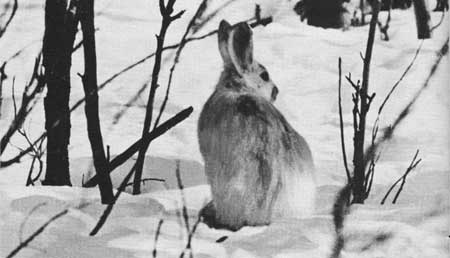 THE SNOWSHOE RABBIT IN ITS WINTER ENVIRONMENT. —Fish and Wildlife Service photo. |
The so-called SNOWSHOE RABBIT is a hare which nests on the surface of the ground. Its fur changes in color from grayish-brown in summer to white in winter. It is a denizen of the spruce-fir and lodgepole pine forests and the tundra. It hops about the snow on its huge, furry, snowshoe feet, apparently finding the severe winters of the high country no great hardship. It is not common in the park, and therefore is not often seen.
Motorists on the highest parts of the Trail Ridge Road often see the PIKA, an interesting little creature which looks like a small, grayish guinea pig but is really a near relative of the rabbit. It is always found in the high country, seldom going below 9,000 feet altitude. This little animal spends its life in the rock slides and talus piles mostly above timberline. Despite the subzero temperature of the tundra belt, it does not hibernate. Its habit of storing up little bundles of mountain grasses and other alpine plants has given it the name of alpine hay-maker. It seems to have favorite sunning spots from which it greets the traveler with shrill squeaks. A common name for it is cony, which is better reserved for an Old World mammal with which it is quite unrelated. A good place to see the pika is Rock Cut on Trail Ridge Road.

|

|
|
|
|
Last Modified: Sat, Nov 4 2006 10:00:00 pm PST |


